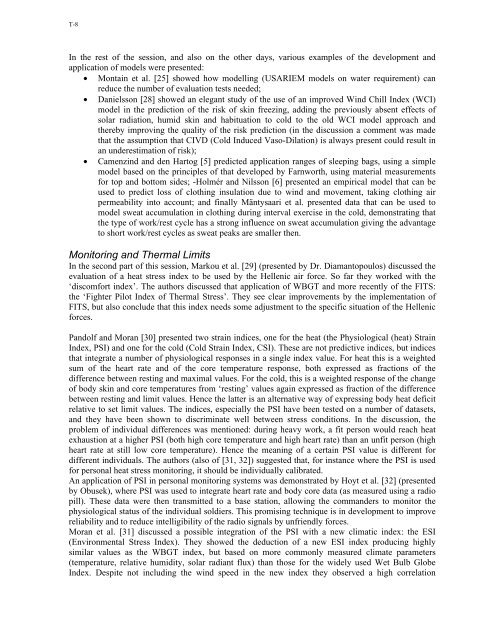Technical Evaluation Report - Nato
Technical Evaluation Report - Nato
Technical Evaluation Report - Nato
Create successful ePaper yourself
Turn your PDF publications into a flip-book with our unique Google optimized e-Paper software.
T-8<br />
In the rest of the session, and also on the other days, various examples of the development and<br />
application of models were presented:<br />
• Montain et al. [25] showed how modelling (USARIEM models on water requirement) can<br />
reduce the number of evaluation tests needed;<br />
• Danielsson [28] showed an elegant study of the use of an improved Wind Chill Index (WCI)<br />
model in the prediction of the risk of skin freezing, adding the previously absent effects of<br />
solar radiation, humid skin and habituation to cold to the old WCI model approach and<br />
thereby improving the quality of the risk prediction (in the discussion a comment was made<br />
that the assumption that CIVD (Cold Induced Vaso-Dilation) is always present could result in<br />
an underestimation of risk);<br />
• Camenzind and den Hartog [5] predicted application ranges of sleeping bags, using a simple<br />
model based on the principles of that developed by Farnworth, using material measurements<br />
for top and bottom sides; -Holmér and Nilsson [6] presented an empirical model that can be<br />
used to predict loss of clothing insulation due to wind and movement, taking clothing air<br />
permeability into account; and finally Mäntysaari et al. presented data that can be used to<br />
model sweat accumulation in clothing during interval exercise in the cold, demonstrating that<br />
the type of work/rest cycle has a strong influence on sweat accumulation giving the advantage<br />
to short work/rest cycles as sweat peaks are smaller then.<br />
Monitoring and Thermal Limits<br />
In the second part of this session, Markou et al. [29] (presented by Dr. Diamantopoulos) discussed the<br />
evaluation of a heat stress index to be used by the Hellenic air force. So far they worked with the<br />
‘discomfort index’. The authors discussed that application of WBGT and more recently of the FITS:<br />
the ‘Fighter Pilot Index of Thermal Stress’. They see clear improvements by the implementation of<br />
FITS, but also conclude that this index needs some adjustment to the specific situation of the Hellenic<br />
forces.<br />
Pandolf and Moran [30] presented two strain indices, one for the heat (the Physiological (heat) Strain<br />
Index, PSI) and one for the cold (Cold Strain Index, CSI). These are not predictive indices, but indices<br />
that integrate a number of physiological responses in a single index value. For heat this is a weighted<br />
sum of the heart rate and of the core temperature response, both expressed as fractions of the<br />
difference between resting and maximal values. For the cold, this is a weighted response of the change<br />
of body skin and core temperatures from ‘resting’ values again expressed as fraction of the difference<br />
between resting and limit values. Hence the latter is an alternative way of expressing body heat deficit<br />
relative to set limit values. The indices, especially the PSI have been tested on a number of datasets,<br />
and they have been shown to discriminate well between stress conditions. In the discussion, the<br />
problem of individual differences was mentioned: during heavy work, a fit person would reach heat<br />
exhaustion at a higher PSI (both high core temperature and high heart rate) than an unfit person (high<br />
heart rate at still low core temperature). Hence the meaning of a certain PSI value is different for<br />
different individuals. The authors (also of [31, 32]) suggested that, for instance where the PSI is used<br />
for personal heat stress monitoring, it should be individually calibrated.<br />
An application of PSI in personal monitoring systems was demonstrated by Hoyt et al. [32] (presented<br />
by Obusek), where PSI was used to integrate heart rate and body core data (as measured using a radio<br />
pill). These data were then transmitted to a base station, allowing the commanders to monitor the<br />
physiological status of the individual soldiers. This promising technique is in development to improve<br />
reliability and to reduce intelligibility of the radio signals by unfriendly forces.<br />
Moran et al. [31] discussed a possible integration of the PSI with a new climatic index: the ESI<br />
(Environmental Stress Index). They showed the deduction of a new ESI index producing highly<br />
similar values as the WBGT index, but based on more commonly measured climate parameters<br />
(temperature, relative humidity, solar radiant flux) than those for the widely used Wet Bulb Globe<br />
Index. Despite not including the wind speed in the new index they observed a high correlation

















